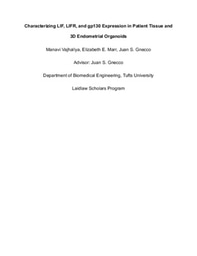Examining LIF and Receptor Expression in Endometrial Tissue
Introduction
Endometriosis occurs when the inner lining of the uterus, known as the endometrium, begins to grow outside the uterus. It is a disease found in about 10% of women, and its symptoms include pelvic pain, excessive bleeding, and infertility. Leukemia inhibitory factor (LIF) is a cytokine important in fertility, known to be regulated when the endometrium is receptive during the menstrual cycle. Studies have shown that LIF expression is reduced in individuals with endometriosis, suggesting a potential link between its dysregulation and infertility in these patients.
Objectives and Methodologies
My research addresses the underlying question: how does the presence and distribution of LIF in patient tissue contribute to our understanding of its role in fertility and endometriosis? Under the guidance of Dr. Gnecco and PhD candidate Elizabeth Marr at the Gnecco Lab, I aim to characterize the expression of LIF, its receptor (LIFR), and the co-receptor gp130 in endometrial tissue samples from patients with endometriosis. LIF signaling is critical for endometrial receptivity and successful implantation, and its disruption may contribute to the infertility observed in affected individuals.
During the first phase of my project, I will prepare endometrial tissue samples from 15 patients by sectioning and staining them using immunohistochemistry (IHC) to detect LIF, LIFR, and gp130 expression. To validate the IHC protocol, I will initially perform staining for the estrogen receptor, a well-characterized marker of endometrial tissue. Following validation, I will optimize antibody concentrations for each target protein to ensure specific and reproducible staining.
To visualize protein expression, I will use confocal microscopy, which enables high-resolution, three-dimensional imaging of tissue architecture. I will then analyze and quantify the expression levels of LIF, LIFR, and gp130 using IMARIS, a software tool designed for detailed image-based analysis. Through this approach, I hope to clarify how disruptions in LIF signaling components may contribute to the pathophysiology of endometriosis and its associated infertility.
Conclusion
The findings of this project will deepen our understanding of LIF signaling involved in endometriosis, provide insight into factors contributing to infertility in affected patients, and potentially guide future strategies for diagnosis and treatment.

Please sign in
If you are a registered user on Laidlaw Scholars Network, please sign in